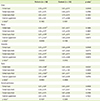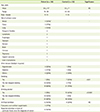1. Ministry of Health & Welfare. National Cancer Center. Korea Central Cancer Registry. Annual report of cancer statistics in Korea in 2010. Goyang: Korea Central Cancer Registry;2012.
3. Barrera R. Nutritional support in cancer patients. JPEN J Parenter Enteral Nutr. 2002; 26:S63–S71.

4. Bloch AS. The role of nutrition during cancer treatment. J Womens Health. 1997; 6:671–675.

5. Comeau TB, Epstein JB, Migas C. Taste and smell dysfunction in patients receiving chemotherapy: a review of current knowledge. Support Care Cancer. 2001; 9:575–580.

6. Andreyev HJ, Norman AR, Oates J, Cunningham D. Why do patients with weight loss have a worse outcome when undergoing chemotherapy for gastrointestinal malignancies? Eur J Cancer. 1998; 34:503–509.

7. DeWys WD. Changes in taste sensation and feeding behaviour in cancer patients: a review. J Hum Nutr. 1978; 32:447–453.
8. DeWys WD. Nutritional care of the cancer patient. JAMA. 1980; 244:374–376.

9. Huldij A, Giesbers A, Klein Poelhuis EH, Hart AA, Hulshof KF, Bruning PF. Alterations in taste appreciation in cancer patients during treatment. Cancer Nurs. 1986; 9:38–42.

10. Carson JA, Gormican A. Taste acuity and food attitudes of selected patients with cancer. J Am Diet Assoc. 1977; 70:361–365.

11. Wickham RS, Rehwaldt M, Kefer C, Shott S, Abbas K, Glynn-Tucker E, Potter C, Blendowski C. Taste changes experienced by patients receiving chemotherapy. Oncol Nurs Forum. 1999; 26:697–706.
12. Ovesen L, Allingstrup L. Different quantities of two commercial liquid diets consumed by weight-losing cancer patients. JPEN J Parenter Enteral Nutr. 1992; 16:275–278.

13. Auty PL, Standing MA, Humphrey C. Relative palatability of liquid enteral feeds for general hospital patients: simple method of assessment. Br Med J (Clin Res Ed). 1983; 287:530.

14. Fuller L. The acceptability of sweet and savoury sip feeds. Hum Nutr Appl Nutr. 1985; 39:422–425.
15. Higashi-Okai K, Kanbara K, Amano K, Hagiwara A, Sugita C, Matsumoto N, Okai Y. Potent antioxidative and antigenotoxic activity in aqueous extract of Japanese rice bran--association with peroxidase activity. Phytother Res. 2004; 18:628–633.

16. Torosian MH, Daly JM. Nutritional support in the cancer-bearing host. Effects on host and tumor. Cancer. 1986; 58:1915–1929.

17. Bozzetti F. Effects of artificial nutrition on the nutritional status of cancer patients. JPEN J Parenter Enteral Nutr. 1989; 13:406–420.

18. Pirlich M, Schütz T, Kemps M, Luhman N, Burmester GR, Baumann G, Plauth M, Lübke HJ, Lochs H. Prevalence of malnutrition in hospitalized medical patients: impact of underlying disease. Dig Dis. 2003; 21:245–251.

20. Boltong A, Keast R. The influence of chemotherapy on taste perception and food hedonics: a systematic review. Cancer Treat Rev. 2012; 38:152–163.

21. Gómez-Candela C, Villarino Sanz M, Horrisberger A, Loria Kohen V, Bermejo LM, Zamora Auñón P. Efficacy evaluation of an oral powder supplement enriched with eicosapentaenoic acid in cancer patients. Nutr Hosp. 2011; 26:1385–1393.
22. Zhang JW, Du P, Chen DW, Cui L, Ying CM. Effect of viable Bifidobacterium supplement on the immune status and inflammatory response in patients undergoing resection for colorectal cancer. Zhonghua Wei Chang Wai Ke Za Zhi. 2010; 13:40–43.
23. Basker D. Critical values of differences among rank sums for multiple comparisons. Food Tech. 1988; 42:79–84.






 PDF
PDF ePub
ePub Citation
Citation Print
Print






 XML Download
XML Download